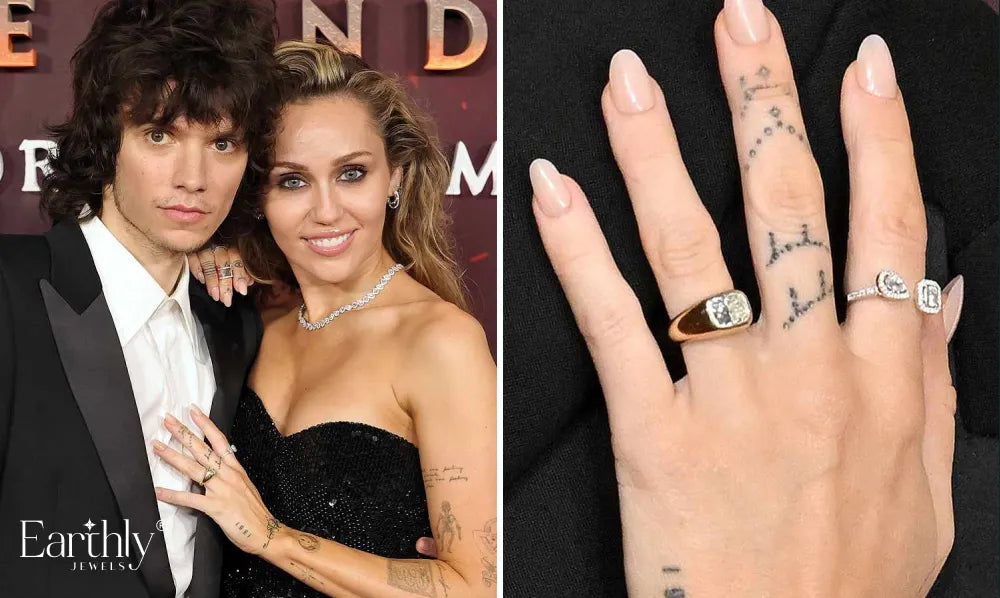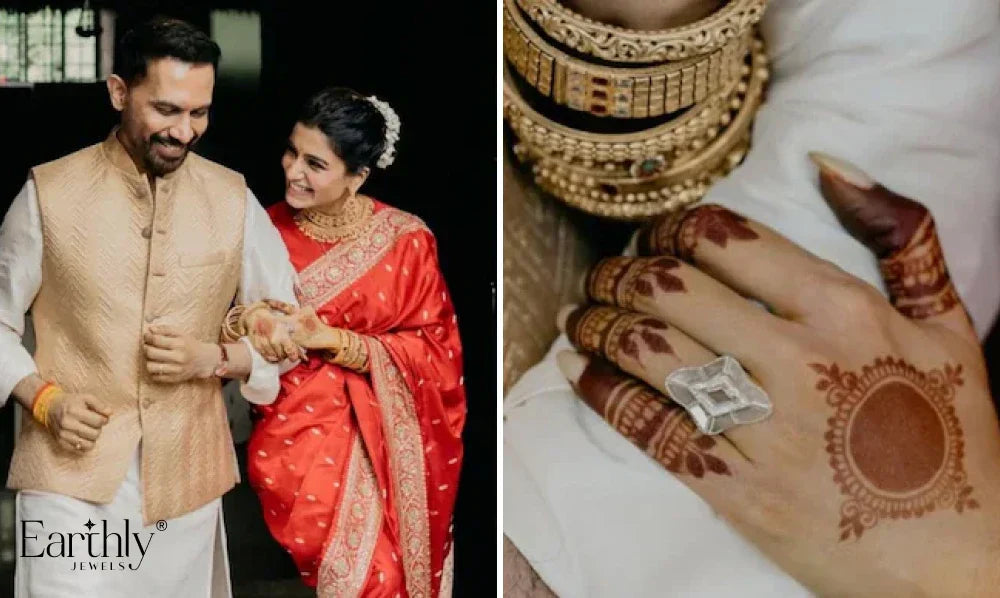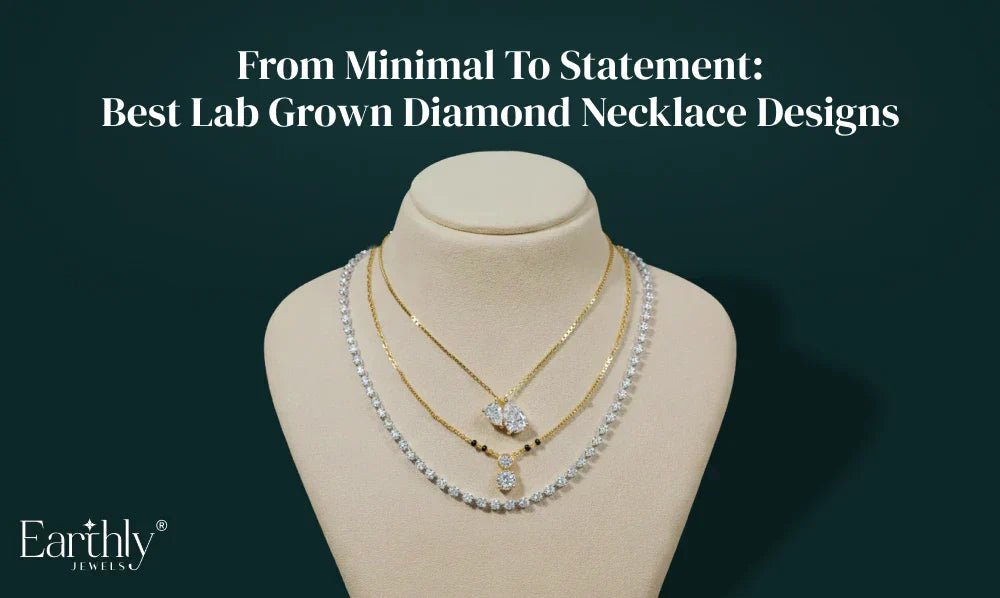
Choosing a diamond ring for engagement marks the beginning of a beautiful journey. In Indian tradition, this cherished piece of jewellery often becomes a timeless heirloom, making its quality truly important. As you explore the world of diamonds, you’ll come across the 4Cs—Carat, Colour, Clarity, and Cut—with the Ideal Cut Diamond standing out as the perfect balance of brilliance and precision.
While all four are vital, expert jewellers agree that Cut is the most crucial element. It determines a diamond’s spectacular visual performance and fire. A poorly cut diamond, even if large and flawless, will simply look dull.
At Earthly Jewels, we believe in providing not just luxury, but intelligent luxury. This means offering meticulously crafted lab grown diamond solitaire ring options that achieve the highest possible cut standards. This guide will empower you to understand the Ideal Cut. It will help ensure your chosen ring possesses maximum fire and life.
1. What is an Ideal Cut Diamond?
The "Cut" of a diamond is often misunderstood. It does not refer to the stone's shape, like round or oval. Instead, it describes the precision of its angles, proportions, and craftsmanship.
A Perfectly Cut Diamond is a stone that has been cut to exact, scientifically calculated proportions. The cutter's goal is to position every facet so that when light enters the diamond through the top, it travels through the stone, bounces off the internal surfaces, and reflects entirely back out through the top (the table and crown).
This flawless light return is what creates the captivating spectacle of fire and life—the intense flashes of colour and light that make a diamond legendary. An Ideal Cut guarantees the optimal interaction between light and diamond.
2. Cut vs. Shape – Why They Are Not the Same
Understanding this distinction is the first step toward a smart purchase.
- Diamond Shape: This is the geometry of the diamond when viewed from above. Popular shapes include Round, Oval, Pear, and Princess. It's purely a matter of preference. You can explore our diverse selection of lab grown engagement rings.
- Diamond Cut (or Cut Grade): This is a measure of the diamond's artistry. It evaluates how well the cutter followed the ideal mathematical proportions. The Cut Grade is a measure of quality, not geometry.
The finest lab grown diamond solitaire ring options, like those in our solitaire collection , will always carry a high Cut Grade (Excellent or Ideal) on their certification.
3. How Cut Affects Light and Beauty
The precision of the diamond's cut determines how well it manages the three optical effects responsible for its overall beauty:
- White Light Return: The amount of white light reflected back to the viewer. This is maximised by perfect pavilion depth.
- Fire: The scattering of white light into the spectral colours of the rainbow. This is controlled by the crown angle.
- Scintillation: The flashes of light and the pattern of light and dark areas created when the diamond or the wearer moves.
A diamond that is cut too shallow or too deep will allow light to escape (or "leak") through the bottom or sides, resulting in a dull, muted stone. The Ideal Cut ensures maximum fire and life.
Ideal Proportions Chart (Simplified)
| Component | Ideal Range | Why it Matters |
| Table Percentage | 54% to 58% | Optimal size for light entry and reflection. |
| Depth Percentage | 59% to 62.3% | Ensures light is reflected back, not escaping the bottom. |
| Crown Angle | 34° to 35° | Balances fire and white light return. |
| Pavilion Angle | 40.6° to 41° | Critical angle for total internal reflection of light. |
| Girdle Thickness | Thin to Medium | Best compromise for durability and weight distribution. |
| Culet Size | None/Pointed | Prevents light leakage at the base of the stone. |
For the Round lab grown diamond solitaire ring—the gold standard for Cut assessment—grading laboratories look for very specific percentage ranges. To achieve an Ideal or Excellent Cut grade, look for these parameters: Certified lab grown diamonds with BIS-HUID Gold – Explore Now at Earthly Jewels.
Fancy Shapes vs. Round Cut

While the strict "Ideal Cut" designation is typically reserved for the Round Cut Diamond (due to the extensive research on its symmetry), buyers of Fancy Shapes (non-round stones) must still prioritise the Cut Grade elements of symmetry and polish.
| Feature | Round Cut Diamond | Fancy Shaped Diamond (e.g., Oval, Pear) |
| Cut Grade | Receives a formal 'Cut Grade' (Excellent/Ideal is best). | Assessed primarily by Symmetry and Polish grades (aim for Excellent/Very Good). |
| Light Return | Highest potential for total light return and fire. | Excellent light return is possible, but depends on the cutter's skill. |
| Appearance | Classic, timeless, and scientifically perfect proportions. | Unique, modern, often appears larger per carat weight due to shape. |
| Specific Risk | Minimal | Potential for a 'bow tie' (a dark area across the centre). |
Product Recommendation: Elegant Fancy Shapes
For the buyer who desires a distinct look without compromising on quality, our fancy shapes are cut with exceptional precision.

An elegant bypass setting highlights the elongated form of this superb oval solitaire. Its excellent symmetry ensures captivating light play.
Why Cut Matters More Than Carat for Engagement Rings
Many first-time buyers make the mistake of prioritising carat weight—the diamond's weight—over its cut quality. In reality, a well-cut diamond can easily outshine a larger, poorly-cut stone.
- A 1.0 Carat Perfectly Cut Diamond: Will reflect virtually all incoming light, appearing intensely vibrant, lively, and often larger than its weight suggests because the weight is spread across the top surface, not hidden in a deep pavilion.
- A 1.2 Carat Poor Cut Diamond: May have a deep, heavy pavilion that hides weight at the bottom, making it look smaller than a 1.0 carat Ideal Cut. Crucially, it will lose light through the bottom, resulting in a dull, lifeless appearance.
When selecting a diamond ring for engagement, especially in a lab grown diamond solitaire ring, an Excellent or Ideal Cut should be the first C you prioritise to ensure the ultimate wow-factor.
Real Buying Tips for First-Time Buyers in India
Navigating the market for an engagement ring requires a clear strategy. Here are expert tips for a confident purchase:
1. Prioritise the Cut Grade (First C):
- For Round Diamonds: Only consider "Excellent" or "Ideal" cut grades (often interchangeable, depending on the lab).
- For Fancy Shapes: Look for "Excellent" or "Very Good" grades for both Polish and Symmetry on the certification.
2. Insist on Certification:
- Always ensure your lab grown diamond is certified by a globally recognised authority such as the IGI (International Gemological Institute) or GIA ( Gemological Institute of America). The certificate is the document verifying the cut grade and all other C's.
3. Understand Lab-Grown Value:
- Opting for a lab grown diamond, like those from Earthly Jewels, allows you to maximise the Cut quality and Carat weight within your budget. Since the origin is ethical and the cost is significantly lower, you can comfortably choose a higher Cut grade for that magnificent fire.
4. Check the Diamond Plot:
- For transparency, ask to view the diamond's plot on the certificate. This diagram illustrates the stone's exact proportions and any inclusions, providing full assurance of its quality.
5. Look for a Trusted Retailer:
- Purchase from a specialist who openly discusses the 4Cs and provides BIS-HUID hallmarking for the gold setting. Trust and transparency are essential for such a meaningful investment.
Earthly Jewels: Curated Solitaire Rings for Your Perfect Engagement
At Earthly Jewels, every lab grown diamond is selected for its superior cut, ensuring a lifetime of unforgettable fire. Our commitment to ethical sourcing and master craftsmanship means you receive a diamond of unmatched quality and responsible luxury.
Round Cut Masterpieces
| Product | Description |
| Round Shape Solitaire with Double Hidden Halo Ring | A classic lab grown diamond solitaire ring elevated with a hidden double halo for maximum size perception and light-catching angles. |
| Round Solitaire Floral Pave Prongs Ring with Twisted Shank | A romantic design featuring delicate floral pave detailing on the prongs and a unique twisted shank. |
| 2 Carat Round Solitaire Diamond Ring | The quintessential statement diamond ring for engagement, showcasing the unparalleled fire of an Ideal Cut. |
Unique Fancy Shape Designs
| Product | Description |
| Yellow Radiant Solitaire Engagement Ring with Tapered Baguette | A striking yellow radiant-cut centre stone, perfectly complemented by sleek tapered baguette side diamonds for an Art Deco feel. |
| Pear Shaped Diamond Fluid Ring with Stack Band | A graceful pear-shaped diamond set in a contemporary 'fluid' band that comes paired with a matching stackable band. |
| Oval Solitaire Diamond Bypass Setting Ring | The elongated oval shape appears larger on the finger, set in an elegant bypass design that is modern yet timeless. |
7. Why Cut Matters More Than Carat
It's a mistake to prioritise size (Carat Weight) over quality (Cut Grade). The weight of a diamond means nothing if the cut is poor.
- A larger diamond with a poor cut will have light "leakage," making the stone look dull and lifeless, even in bright light. It will appear smaller and less impressive than a smaller, well-cut diamond.
- A diamond with an Ideal Cut maximises light return, making the stone appear more vibrant, and often larger, than its actual weight would suggest. The skilled cutting ensures the weight is not hidden in the depth.
For your diamond ring for engagement, invest in the highest Cut Grade you can afford—you will not regret the breath taking fire it delivers.
8. Real Buying Guide + Mistakes to Avoid
Buying an engagement ring is a significant investment. Here are practical tips to ensure a successful purchase:
A. Key Buying Checklist
- Prioritise Cut: Always look for "Excellent" or "Ideal" Cut Grade on the certificate first.
- Check Certification: Insist on an independent, globally recognised certificate (IGI or GIA) for your lab grown diamond. This verifies the cut quality.
- Verify Metal Purity: Ensure the gold setting is BIS-HUID hallmarked, guaranteeing its purity, which is the standard of trust for quality jewellers like Earthly Jewels.
- Ask About Light Performance: A trusted jeweller should be able to explain the diamond’s specific cut proportions and why they achieve superior light performance.
B. Common Mistakes to Avoid
- Deep Cuts: Avoid diamonds that are cut too deep (high depth percentage) just to achieve a certain carat weight. The stone will appear small and dark.
- Poor Symmetry/Polish: For any fancy shape, sacrificing symmetry and polish for lower cost will result in an inferior stone with uneven light reflection.
- Ignoring the Girdle: A very thick girdle adds weight without visual size; a very thin one risks chipping the diamond. Aim for a 'Thin' to 'Medium' girdle.
Learn more about our ethical standards and commitment to quality: about Earthly Jewels .
Conclusion: Your Ideal Cut Diamond Awaits – Begin Your Journey
The Ideal Cut is the key to unlocking the true potential of any diamond. It is the defining feature that transforms a beautiful stone into a magnificent, fire-filled symbol of your commitment.
By choosing a lab grown diamond from Earthly Jewels, you are selecting a stone that combines the highest ethical standards with unparalleled cutting precision, offering you greater value and breathtaking quality.
Take the next step in your love story. Find the expertly cut solitaire that speaks to your heart.
Shop the full Solitaire Collection at Earthly Jewels and secure the perfect diamond ring for engagement today.
Need assistance with your purchase? Contact us to speak with a diamond expert.
Frequently Asked Questions (FAQs)
Q1. Are Ideal Cut proportions the same for all diamond shapes?
No, the specific "Ideal Cut" parameters (like the detailed table percentages) are strictly defined only for the Round Brilliant Cut diamond. For all other shapes (Fancy Shapes), the focus shifts to achieving "Excellent" or "Very Good" Symmetry and Polish grades to ensure the best possible light performance for that shape.
Q2. Is a lab grown diamond Ideal Cut as good as a mined diamond Ideal Cut?
Yes, absolutely. Lab grown diamonds have the same composition and brilliance as natural ones. They are cut by the same master artisans, using the same precise tools, and are graded by the same reputable labs (like IGI). An Ideal Cut lab grown diamond is cut to the same master precision as an Ideal Cut mined diamond.
Q3. Does Perfectly Cut Diamond cost more?
Yes, diamonds with higher Cut grades (Excellent/Ideal) generally command a higher price because they require more time, skill, and material wastage during the cutting process. However, the slightly higher cost is well worth the incredible increase in the stone’s overall beauty and visual impact.
Q4. What is a common mistake buyers make regarding the diamond Cut?
The most common mistake is sacrificing the Cut grade to achieve a slightly higher Carat weight. Buyers often choose a larger stone with a lower cut grade (e.g., Very Good or Good), resulting in a duller appearance. Prioritising an Excellent/Ideal Cut ensures maximum fire, which makes the stone look alive and often visually larger.
Q5. What is the Ideal Cut for a lab grown diamond solitaire ring?
The best cut for a lab grown diamond solitaire ring is one graded as Excellent or Ideal by a recognised laboratory like IGI. This means the diamond’s proportions, symmetry, and polish are perfect, guaranteeing the utmost reflection of light, fire, and a stunning presence on the hand.












Share:
Promise Ring vs. Engagement Ring: The Indian Couple's Guide to Commitment Jewellery
Top 5 Fancy Colored Diamond Engagement Rings for Modern Brides